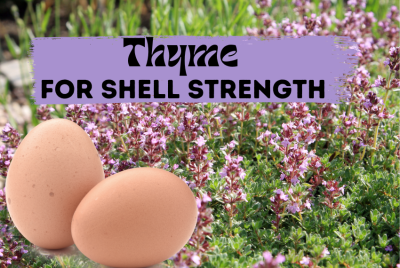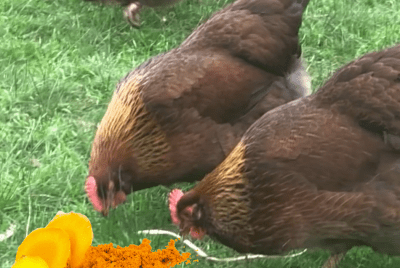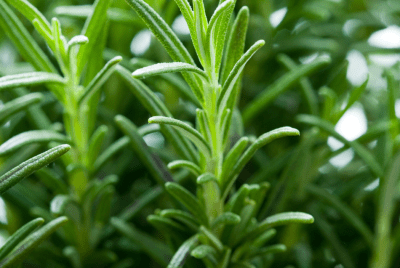What Can Chickens Eat and Why
What Can Chickens Eat and Why
1. Introduction:What Can Chickens Eat and Why
Chickens, the quintessential backyard companions, can consume an expansive range of foods due to their omnivorous nature. In this article we will show what can chickens eat and why. Their multifaceted diet includes fruits, vegetables, grains, and more, and understanding this can help in offering them a balanced and nutritious diet, ensuring they remain healthy, happy, and productive. This comprehensive guide aims to elaborate on the myriad of dietary options suitable for chickens, striking the right balance between nutrition and taste, ensuring the well-being of these lively creatures.

1.1. Fruits and Vegetables: A Nutritional Cornucopia
Chickens naturally gravitate towards a diverse range of fruits and vegetables, finding them both palatable and nutritionally rewarding. Introducing such variety, including apples, bananas, berries, broccoli, carrots, and peas, not only satiates their diverse palate but also plays a pivotal role in furnishing them with an array of essential vitamins and minerals.
1.2. Nutritional Benefits and Diversity:
Fruits and vegetables are reservoirs of nutrients and antioxidants, each bringing its unique nutritional composition to the table. Apples, rich in dietary fiber and Vitamin C, promote digestive health and fortify the immune system. Bananas are packed with potassium, crucial for maintaining heart health and proper muscle function. Berries, brimming with antioxidants, offer protection against cellular oxidative stress, and vegetables like broccoli and carrots are loaded with vitamins A, C, and K, benefiting vision, immune function, and blood coagulation respectively.
This diversity ensures that chickens receive a spectrum of nutrients, promoting balanced nutrition, enhancing disease resistance, and contributing to colorful and appealing yolk pigmentation. The nutritional variance provided by different fruits and vegetables is optimal for health and well-being of the flock, making dietary diversity a crucial aspect of poultry nutrition.
Watermelon is a great treat – Try freezing it for hot summer days.

1.3. Hydration
The high water content in fruits and vegetables is a great assist for hydration, particularly during the hotter seasons, helping maintain body temperature and ensuring chickens stay active and healthy. However, while the nutritional and hydration benefits are substantial, moderation is key. Excessive consumption can lead to nutritional imbalances and obesity, and thus, portion and frequency control is important.
1.4. Caution with Certain Fruits and Vegetables:
Not all fruits and vegetables are suitable for chickens. Citrus fruits can lead to acidity and digestive discomfort and should generally be avoided. Likewise, onions and garlic can alter the flavor of the eggs and can be toxic in high quantities. Furthermore, the pits and skins of avocados contain persin, harmful to chickens. Always ensure that the fruits and vegetables are fresh and free from molds to avoid the risk of toxicity and infections.
1.5. Practical Recommendations:
To prevent choking and facilitate consumption, fruits and vegetables should be chopped into manageable sizes. Mixing them or combining with other food sources can ensure a balanced diet and enhance appeal. Periodically rotating different fruits and vegetables can prevent dietary monotony and ensure a balanced intake of different nutrients. It’s also essential to observe the chickens after introducing new food items to promptly identify and address any adverse reactions.
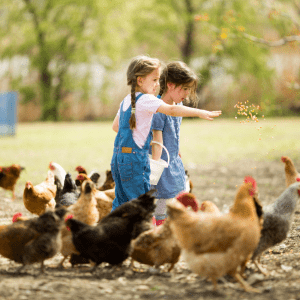
1.6. Health and Productivity Enhancement:
The thoughtful inclusion of fruits and vegetables in the diet can significantly elevate the health, vitality, and productivity of chickens. They lead to improved egg quality, reinforced shells, increased laying frequency, and contribute to the overall happiness and well-being of the chickens, reducing susceptibility to diseases and promoting active and contented flocks.
1.7. Fruits and Vegetables Summary:
Fruits and vegetables are integral to the dietary mosaic of chickens, contributing significantly to their nutritional welfare and gastronomical satisfaction. By offering a variety of fruits and vegetables, we enrich their diet with essential nutrients and antioxidants, fostering healthier and more productive flocks. However, this requires informed and responsible feeding practices, with careful consideration to the choice, quantity, and variety of fruits and vegetables, ensuring optimal benefits while averting potential risks.
Chickens have an inherent love for fruits like apples, bananas, and berries, and vegetables such as broccoli, carrots, and peas. These not only satiate their palate but also serve as substantial sources of vitamins and minerals. They provide hydration and can support overall health, helping in preventing diseases. However, one must be cautious as not all fruits and vegetables are suitable. Citrus fruits, onions, and garlic can be detrimental, affecting egg flavor and causing health issues.
2. Grains and Cereals:
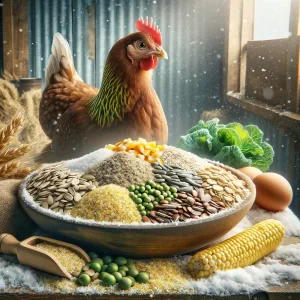
Grains are indispensable for chickens, fulfilling their nutritional needs and serving as a rich source of energy. A variety of grains like barley, oats, quinoa, corn, and wheat can be included in their diet. Each grain brings its unique nutritional profile, providing essential proteins, vitamins, minerals, and other elements crucial for optimal health and growth.
- Corn, a staple in poultry diets, is a powerhouse of energy, providing essential carbohydrates that help in maintaining body heat, especially in colder climates. It is abundant in vitamins A and C, benefiting eye health and immunity. However, it is deficient in amino acids and lysine, necessitating a balanced inclusion with other protein-rich foods.
- Wheat is another valuable grain for chickens. It’s rich in proteins and comes packed with essential vitamins like Vitamin B, crucial for energy metabolism and overall neurological health. It is also rich in minerals like manganese, beneficial for bone health and eggshell formation, making it an excellent choice for laying hens.
- Barley is laden with fibers and beta-glucans, aiding digestion and promoting gut health. Its nutritional composition includes manganese, selenium, and B vitamins, contributing to bone health, immune response, and metabolic processes.
- Oats are incredibly nutritious, rich in proteins and dietary fibers. They contain essential vitamins like B vitamins and Vitamin E, and minerals like zinc, iron, and manganese, providing comprehensive nutritional benefits, enhancing immunity, skin health, and metabolic function.
- Quinoa, a pseudo-cereal, is a protein-rich grain, containing all nine essential amino acids, making it an excellent protein source for chickens. It also boasts a high content of minerals like magnesium, phosphorus, and manganese, supporting bone health and enzymatic functions.

2.1. Essential Proteins and Amino Acids:
Proteins and amino acids in grains are vital for muscle development, feather formation, and egg production. Lysine and methionine are essential amino acids found in varying proportions in grains, crucial for optimal growth and development. The balanced incorporation of different grains can help in meeting the amino acid requirements of chickens, ensuring their well-being and productivity.
2.2. Vitamins and Essential Elements:
The diverse array of vitamins in grains plays a pivotal role in various physiological functions. B vitamins are essential for energy metabolism and neurological health. Vitamin E is a potent antioxidant, protecting cells from oxidative damage. Vitamin A is paramount for visual health and immune function. These vitamins, coupled with essential elements like iron, zinc, and manganese, offer holistic health benefits, supporting various biological processes, including oxygen transport, immune response, and enzymatic reactions.
2.3. Dietary Implications and Considerations:
While grains are nutritional powerhouses, their incorporation in chicken diets requires meticulous planning and moderation. Excessive intake of energy-rich grains like corn can lead to obesity, while overreliance on a single grain can result in nutritional imbalances. The nutritional composition of grains should be harmonized with the overall dietary intake, ensuring a balanced provision of proteins, vitamins, minerals, and other essential nutrients.
2.4. Grains as Treats and Feed Components:
Grains can be offered as treats or integrated as essential components in commercial feeds. They can be given raw, soaked, or sprouted, with each form offering varied nutritional benefits. Sprouted grains, for instance, have increased levels of vitamins and are easier to digest. The inclusion of grains in commercial feeds is meticulously formulated, maintaining balanced nutrition, and ensuring the overall health and productivity of chickens.
Grains, including barley, oats, and quinoa, are pivotal for chickens, providing the necessary energy and keeping them active. Bread and cereals can also be included, but should be monitored to avoid overconsumption leading to health problems like obesity. Uncooked rice and beans must be strictly avoided due to the digestive complications they can cause.
3. Nuts and Seeds:
Nuts such as almonds and seeds like sunflower seeds are cherished by chickens and are rich in proteins and essential fatty acids, aiding in muscle development and feather health. However, certain nuts like walnuts and pecans are to be excluded as they contain toxins.
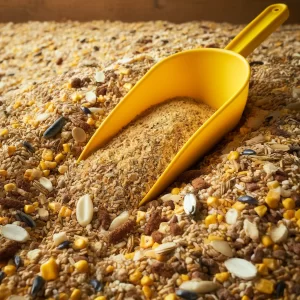
4. Meats and Dairy
Meats and dairy are pivotal components in the diets of numerous animals, serving as indispensable sources of proteins, vitamins, and minerals. They are crucial for promoting growth, enhancing feather production, and fostering optimal egg-laying conditions. When integrating meats and dairy into animal diets, there are a variety of options available, yet it’s essential to maintain a balance to avoid any adverse effects.
4.1. Cooked Meats:
Offering lean, cooked meats is recommended, ensuring all bones and excess fat are removed. It is important to avoid meats with added seasonings, spices, or salt, as these can be harmful. – Chicken: A lean, healthy option when cooked thoroughly and offered in moderation. – Turkey: A beneficial, low-fat option when cooked well and provided in controlled quantities.
4.2. Low-fat Dairy:
Including low-fat dairy products can be beneficial due to their calcium and protein content, essential for bone strength and muscle development. – Cheese: Low-fat cheeses, like cottage cheese, can be offered in small quantities, avoiding highly processed varieties. – Yogurt: Plain, unsweetened yogurt can be a good source of probiotics and calcium.

4.3.Insects:
Some animals thrive on insects, which are protein-rich and can be considered treats. – Mealworms: These are highly nutritious and can be given as treats or mixed with other foods. They are particularly loved by birds and reptiles due to their high protein and fat content, aiding in overall health and feather or scale condition. – Crickets: Another healthy insect option, crickets, are also rich in protein and essential nutrients, perfect for animals with a high protein requirement.
4.4. Avoid Salty and Fatty Foods:
It is crucial to stay away from highly salty and fatty foods like bacon and pork, which can cause health issues due to their high sodium and fat content. The salt can lead to excessive thirst and dehydration, and the fat can lead to obesity and other health complications.
4.5. Eggs:
Eggs can be an excellent source of protein and can be offered boiled or scrambled without any added salt, oil, or seasoning. Egg shells, when cleaned and crushed, can also serve as a calcium supplement.
4.6. Fish:
Cooked fish, free from bones and scales, can also be included in moderate amounts, especially oily fish which are rich in Omega-3 fatty acids, beneficial for heart and brain health.
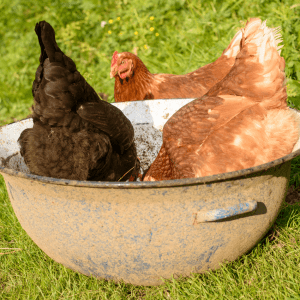
4.7. Balanced Proportion:
It’s essential to maintain balance, moderation, and variety in the diet, ensuring the provision of all necessary nutrients without overloading on proteins and fats. It’s also crucial to understand the specific dietary needs of different animals, as excessive protein can be harmful to some species.
5. Herbs and Flowers:
Herbs including basil, mint, and oregano, along with flowers like marigold and calendula, offer multifarious health benefits, such as immune system enhancement, digestive aid, and improvement in egg quality. They also have pest repelling properties, making them a holistic choice for chicken diet.
6. Commercial Feed:
Commercial feed is the foundational dietary element for chickens, designed to meet their specific nutritional needs at various life stages. High-quality commercial feed ensures balanced nutrition, aiding in optimal growth, health, and productivity.
7. Water:
Water, the elixir of life, is fundamental for chickens, aiding in digestion, nutrient absorption, egg production, and maintaining metabolic processes and body temperature. Clean, fresh water is indispensable and should be available at all times.
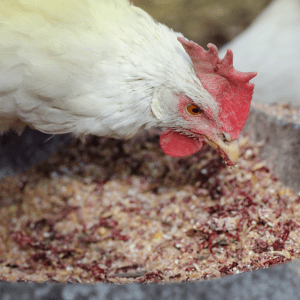
8. Balanced Diet and Moderation:
Maintaining a balanced diet is essential. Overreliance on even healthy treats can lead to nutritional imbalances and reduced egg production. Treats should be healthy, non-toxic, and constitute no more than 10% of their daily intake.
9. Free Ranging and Foraging:
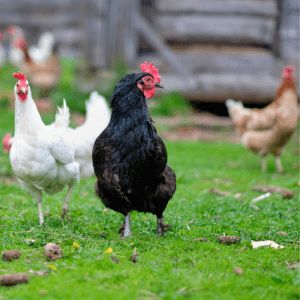
Free ranging is crucial for chickens. It allows them to access a variety of natural foods, enriching their diet and keeping them physically and mentally healthy. Proper precautions must be undertaken to protect free-ranging chickens from predators and to regularly check them for parasites.
Dietary Implications on Chicken Health and Productivity:
The nutritional intake of chickens has direct implications on their health, growth, and egg production. A well-balanced diet can fortify them against diseases, ensure robust growth, and enhance egg production and quality. Inadequate or imbalanced nutrition can lead to a plethora of health issues, including weakened immunity, stunted growth, and reduced productivity.
Dietary Considerations and Adjustments:
Each chicken is unique, and dietary considerations and adjustments may be required based on their breed, age, health status, and specific nutritional needs. Young chicks require protein-rich diets for growth while laying hens need calcium-rich diets to produce healthy eggs. Observing their eating habits, health status, and egg production can help in making necessary adjustments to their diet, ensuring their well-being.

Summary of what chickens can eat and why:
In conclusion of what chickens can eat and why: creating a balanced and nutritious dietary regimen for chickens involves a diverse array of foods, careful considerations, and responsible feeding practices. While commercial feed forms the foundation, a combination of fruits, vegetables, grains, proteins, and adequate water is crucial. Avoidance of harmful foods, moderation in treats, and allowing free-ranging for natural foraging are key practices for healthy, happy chickens.
By enhancing our understanding and adopting best practices in poultry nutrition, we can ensure our feathered friends thrive and continue to be our delightful companions, providing us with fresh, nutritious eggs.
Other Articles you might enjoy:
Common Garden Plants Toxic To Chickens
Can chickens Eat Banana Grapes Tomatoes Apples Pineapples
How to make your own DIY Healthy Homemade Chicken Feed












